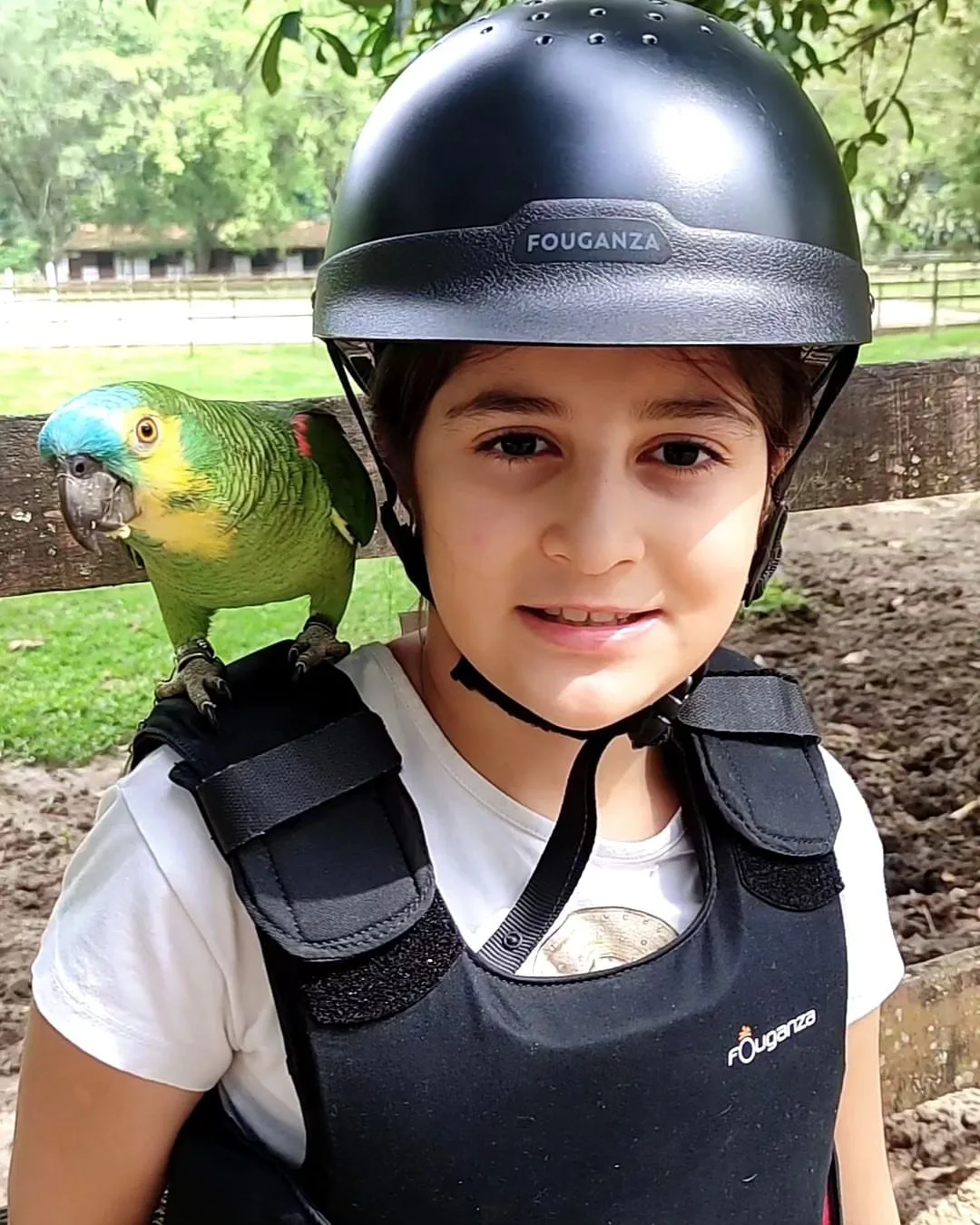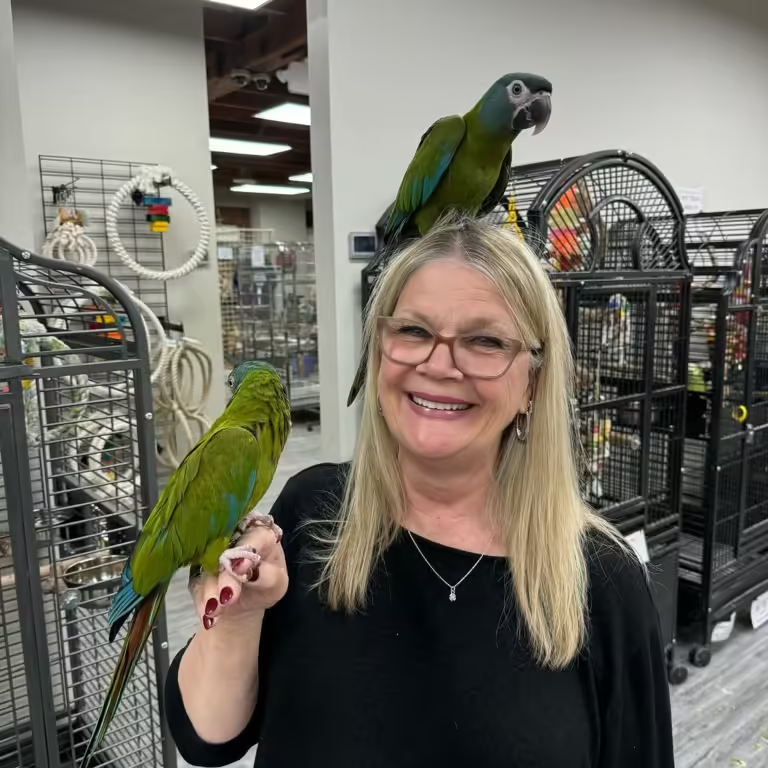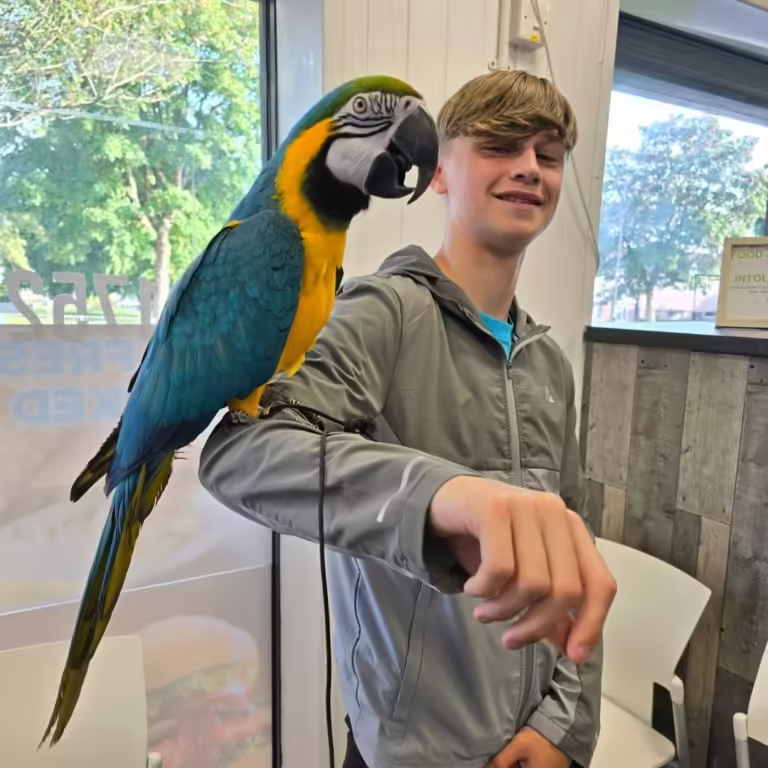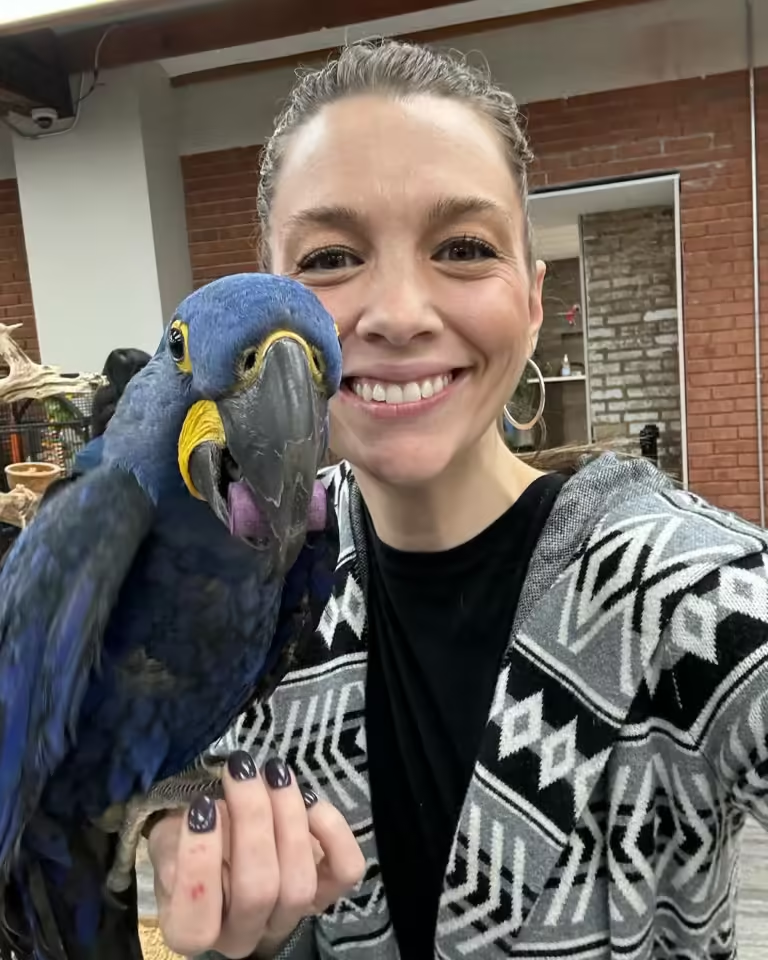- May 22, 2024
Blue Quaker Parrot: 10 Surprising Facts

Looking to add a vibrant and charming companion to your home, like pet birds or quaker parakeets? Consult a vet or avian enthusiast for more information. Look no further than the blue quaker parrot! These delightful birds are known for their stunning blue plumage, playful personalities, and intelligence. But with so many options out there, how do you choose the perfect one for you to look, train, tail, and people? We’ve got you covered!
In this bird listicle, we’ll walk you through everything you need to know about selecting the ideal blue quaker parrot cage. From understanding their unique characteristics and care requirements to finding reputable breeders, ensuring a smooth transition into your home, and training your bird, we’ve got all the tips and insights you need. So, buckle up and get ready to find your feathered friend, the quaker parakeet, and their nests!
Scroll down for reviews of our top picks and discover which blue quaker parrot, a stunning bird, will make the perfect addition to your family’s nests. Don’t miss out on this opportunity to bring joy, beauty, companionship, and quaker parakeets into your life.
Key Takeaways
- Blue Quaker parrots, a bird native to South America, have a unique blue color due to their genetics.
- These quaker parakeets, known for their exceptional vocal mimicry abilities, make them great companions for those who enjoy interacting with talkative bird pets.
- Blue Quaker parrots, being birds, are intelligent problem solvers and require mental stimulation to stay happy and healthy.
- Quaker parakeets have a social and affectionate nature, forming strong bonds with their owners and enjoying being part of a family.
- With their playful and entertaining personalities, Blue Quaker parrots, known as birds, bring joy and laughter to their households.
- Owners should be mindful of providing a balanced diet and regular exercise to prevent obesity in these quaker parakeets, as these birds are vulnerable to weight gain.
Native to South America
Blue Quaker parrots, also known as Monk parakeets, are native bird to the woodlands of South America. They originated in countries like Argentina, Bolivia, Brazil, and Paraguay, where bird and quaker parakeets are commonly found. These vibrant quaker parakeets flourish in their natural habitats within the lush woodlands of South America.
In their native environment, Blue Quaker parrots have adapted to the diverse ecosystems found in this region. They have developed unique characteristics and behaviors, like quaker parakeets, that allow them to thrive in their surroundings. Their bright blue plumage helps them blend in with the foliage, providing camouflage and protection from predators.
These parrots are highly social creatures and can be found living in large flocks in the wild. Their natural habitat provides them with ample opportunities for social interaction and communication with other members of their species. This communal lifestyle contributes to their intelligence and ability to mimic human speech.
The time spent in their native environment has shaped the Blue Quaker parrot into a fascinating and captivating bird species. Their presence adds vibrancy and beauty to the woodlands of South America.
Blue color due to genetics
The vibrant blue color of Blue Quaker parrots is a result of their genetic makeup. Unlike their green and gray counterparts, these parrots have a unique genetic trait that gives them their striking blue hue. Genetics play a crucial role in determining the coloration of these birds, making them stand out among other Quaker parrot varieties.
The blue coloration is not something that can be achieved through external factors or environmental influences. It is an inherent characteristic passed down from generation to generation. This genetic uniqueness sets Blue Quaker parrots apart from other birds in the species, making them highly sought after by bird enthusiasts and collectors alike.
The distinct blue plumage of Blue Quaker parrots adds an element of beauty and elegance to their appearance. It makes them visually captivating and a delightful addition to any aviary or home. Whether observed in the wild or kept as pets, these birds never fail to leave a lasting impression with their stunning blue feathers.
Unique vocal mimicry abilities
Blue Quaker parrots possess exceptional vocal mimicry skills, making them stand out among other pet birds. They have the amazing ability to learn and imitate a diverse vocabulary and sounds, including human speech. In fact, their vocal mimicry abilities often rival those of larger parrot species in terms of clarity.
These intelligent birds can accurately reproduce words and phrases with remarkable precision. Whether it’s mimicking their owner’s voice or imitating various sounds in their environment, Blue Quaker parrots excel at vocal mimicry. They can effortlessly pick up on different tones, accents, and even emotions.
What sets them apart is their ability to articulate words and phrases with great clarity. Their pronunciation is often so accurate that it can be difficult to distinguish between the parrot’s voice and a human’s voice.
If you’re looking for a bird that can entertain you with its talking ability and impress your friends with its human-like speech, the Blue Quaker parrot is an excellent choice. With their unique vocal mimicry abilities, these birds are sure to bring joy and laughter into your home.
Intelligent problem solvers
Blue Quaker parrots are renowned for their exceptional intelligence and impressive problem-solving abilities. These birds have a well-deserved reputation for being highly cognitive creatures that excel in tackling complex tasks.
With their sharp minds and quick wit, Blue Quaker parrots can easily navigate through various puzzles and challenges. They possess the ability to analyze problems, devise strategies, and find innovative solutions. Their problem-solving skills are truly remarkable and set them apart from other avian species.
Studies have shown that these intelligent birds can learn to recognize shapes, colors, and even numbers. They can also imitate human speech with astounding accuracy, making them excellent companions who can engage in meaningful interactions.
Whether it’s unraveling a tricky puzzle or figuring out how to access a treat hidden behind obstacles, Blue Quaker parrots demonstrate their intelligence by successfully solving these complex tasks. Their cognitive abilities make them fascinating pets that offer endless entertainment and intellectual stimulation.
Social and affectionate nature
Blue Quaker parrots are known for their social and affectionate nature, making them ideal companions for avian enthusiasts. These charming birds have unique behavior patterns that set them apart from other species.
One of the standout characteristics of Blue Quaker parrots is their ability to form strong bonds with their owners. They thrive on social interaction and actively seek out human companionship. Whether it’s perching on your shoulder or cuddling up in your lap, these parrots love being close to their favorite humans.
Their friendly and sociable demeanor extends beyond their interactions with their owners. Blue Quaker parrots are also known to get along well with other pets in the household, making them great neighbors for your furry friends.
In captivity, it’s important to provide these birds with plenty of mental stimulation and socialization opportunities. Engaging toys, regular out-of-cage time, and interactive play sessions can help keep them happy and content.
If you’re considering adding a Blue Quaker parrot to your family, be prepared for a companion who will shower you with affection and seek your attention. Their social nature makes them wonderful additions to any household looking for a feathered friend that will truly make life more vibrant.
Playful and entertaining personalities
Blue Quaker parrots are known for their comical personalities and playful nature. They bring joy and amusement to both themselves and their owners through their entertaining behaviors.
These birds are always up for a good time, constantly finding ways to play and have fun. They engage in various activities such as swinging on toys, climbing, and even playing games with their human companions. Their energetic and mischievous nature adds a lively touch to any household.
One of the most endearing qualities of Blue Quaker parrots is their ability to mimic words and sounds. They can learn to imitate human speech, making them excellent talkers and entertainers. Imagine having a feathered friend that can make you laugh with its funny phrases or greet you with a cheerful “hello” every day!
In addition to their playful antics, Blue Quaker parrots also enjoy interacting with their environment. They love exploring new toys, chewing on branches, and investigating anything that catches their curiosity. Providing them with a variety of toys, puzzles, and safe objects to explore will keep them mentally stimulated and entertained.
With their playful and entertaining personalities, Blue Quaker parrots make delightful companions for individuals or families seeking an engaging pet that brings laughter and joy into their lives.
Require mental stimulation
Blue Quaker parrots are highly intelligent birds that require mental stimulation to prevent boredom and behavioral issues. Providing them with regular enrichment activities is crucial to satisfy their intellectual needs and keep them engaged and happy.
These birds thrive on learning new things, so training sessions can be an excellent way to provide mental stimulation. Teaching them tricks, solving puzzles, or engaging in interactive games can help keep their minds active and stimulated.
In addition to training, offering a variety of toys and puzzles can also help keep Blue Quaker parrots mentally stimulated. Toys that encourage problem-solving, such as foraging toys or puzzle feeders, can provide hours of entertainment while challenging their cognitive abilities.
Strong bond with owners
Blue Quaker parrots are known for their ability to form strong and lasting bonds with their owners. These parrots develop deep emotional connections with their human companions, making them a popular choice for those seeking a loyal and affectionate pet.
Building a strong bond with owners is vital for the well-being of these parrots. They thrive on social interaction and require dedicated care to ensure their happiness and mental stimulation. Blue Quaker parrots enjoy spending time with their owners, whether it’s playing games, engaging in training sessions, or simply cuddling up for some quality bonding time.
The bond between a Blue Quaker parrot and its owner goes beyond just companionship. These birds are known to be highly intelligent and can learn to mimic human speech, further strengthening the connection between bird and owner. The trust and love that develops in this relationship is truly special.
If you’re considering adding a Blue Quaker parrot to your family, be prepared to invest a lot of time and effort into building a strong bond. The rewards of having such a devoted companion are immeasurable.
Lifespan of up to 30 years
Blue Quaker parrots are known for their impressive lifespan, with an average lifespan of up to 30 years in captivity. However, it’s important to note that this is just an average, and with proper care, some Blue Quaker parrots can even exceed the age of 30.
To ensure a long and healthy life for your Blue Quaker parrot, providing a well-balanced diet is crucial. This should include a variety of fresh fruits, vegetables, high-quality pellets, and occasional treats. Regular veterinary check-ups are essential to catch any potential health issues early on.
Creating a stimulating environment is also vital for their well-being. Blue Quaker parrots are highly intelligent and social birds that require mental stimulation and social interaction. Providing plenty of toys, puzzles, and regular out-of-cage time can help keep them mentally engaged and prevent boredom.
Vulnerable to obesity
Blue Quaker parrots are vulnerable to obesity if not provided with a balanced and varied diet. Obesity is a common health concern for these birds, often caused by overfeeding.
To ensure their well-being, it is important to maintain a healthy weight through proper nutrition and exercise. A balanced diet consisting of high-quality pellets, fresh fruits, and vegetables is essential for Blue Quaker parrots. Avoid feeding them excessive amounts of fatty or sugary foods, as this can contribute to weight gain.
Incorporating a variety of vegetables into their diet can help prevent obesity and provide essential nutrients. Some recommended vegetables include leafy greens, carrots, bell peppers, and broccoli.
Regular physical activity is also crucial for preventing obesity in Blue Quaker parrots. Encourage them to engage in activities such as flying or climbing to keep them active and maintain a healthy weight.
Summary
In conclusion, the blue quaker parrot is a fascinating and highly sought-after pet. Native to South America, these birds boast a striking blue coloration that is a result of their genetics. They are not only visually appealing but also possess unique vocal mimicry abilities, making them excellent companions for those who appreciate their entertaining and playful personalities.
Furthermore, blue quaker parrots are intelligent problem solvers and form strong bonds with their owners. They require mental stimulation to thrive and can live up to 30 years if properly cared for. However, it’s important to note that they are vulnerable to obesity, so providing a balanced diet and regular exercise is crucial.
If you’re considering adding a blue quaker parrot to your family, be prepared to offer them the attention and mental stimulation they need. These birds are social and affectionate creatures that will reward you with their loyalty and entertaining antics. Take the time to learn about their care requirements and provide them with a loving environment, and you’ll enjoy a long-lasting companionship with these remarkable birds.
Frequently Asked Questions
Can blue quaker parrots be found in the wild?
Yes, blue quaker parrots are native to South America. They can be found in countries such as Brazil, Bolivia, and Paraguay.
How do blue quaker parrots get their blue color?
The blue color of the quaker parrot is a result of genetics. It is caused by a mutation that affects the pigmentation of their feathers.
Do blue quaker parrots have special vocal abilities?
Yes, blue quaker parrots are known for their unique vocal mimicry abilities. They can imitate various sounds and even mimic human speech with practice.
Are blue quaker parrots intelligent?
Absolutely! Blue quaker parrots are highly intelligent problem solvers. They have the ability to learn tricks and solve puzzles, making them an engaging pet to interact with.
What kind of personality do blue quaker parrots have?
Blue quaker parrots are social and affectionate birds. They enjoy spending time with their owners and thrive on attention and interaction.
Do blue quaker parrots require mental stimulation?
Yes, mental stimulation is essential for the well-being of blue quaker parrots. They need toys, puzzles, and regular training sessions to keep their minds active and prevent boredom.
How long do blue quaker parrots live?
Blue quaker parrots have a lifespan of up to 30 years when provided with proper care, nutrition, and a suitable environment.
Are blue quaker parrots prone to obesity?
Yes, blue quaker parrots can be vulnerable to obesity if not provided with a balanced diet and enough exercise. Owners should monitor their food intake and provide opportunities for physical activity.
Tags
What do you think?
Related Articles

Find Parrots for Sale in Aurora IL: Top 5 Must-Visit Spots
Finding the perfect parrot in Aurora, IL, is an exciting adventure for bird lovers. This city offers various options for

Find Parrots for Sale in Trenton NJ: Top 5 Must-See Spots!
Finding the perfect parrot can be a fun adventure. Trenton, NJ, offers plenty of options for bird lovers. From local

Find Parrots for Sale in Woodbridge Township NJ: Top 5 Must-See Spots!
Finding the perfect parrot can be a fun adventure. Woodbridge Township, NJ offers plenty of options for bird lovers. From

